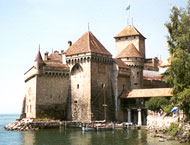
Chillon
Built on a rocky inlet near the eastern shore of Lake Geneva.
History
While the first written reference to the castle comes from 1160, the rock on which the castle was built had been inhabited from antiquity. In 1896 Roman coins and debris were found during excavation work on the Chillon rock, and some suspect that there was a Roman fort or other outpost on the site. The oldest parts of the castle go back to the eleventh century, but the current castle really dates from the middle of the twelth century when Chillon castle belonged to the Counts of Savoy. It was they who completely modified and considerably enlarged it in the thirteenth century, largely over the existing foundations.
In the thirteenth and fourteenth centuries Chillon flourished. It was the favourite summer residence of the Counts of Savoy, guarding the mountain side over the road to Italy, and facing their homeland on the other side of the lake. With the occupation of Vaud by the Bernese, from 1536 to 1798, changes were made, but these were mostly decorative or maintenance. Since Vaud became independent in 1798, Chillon castle has belonged to the Canton (Switzerland's constituent parts are cantons, which are perhaps analogous to the States in the USA or the Lander in Germany).
In the nineteenth century, the castle of Chillon attained fame of another sort. Although it was mentioned in the narratives of writers and poets such as Alexandre Dumas, Rousseau, Shelley, and Victor Hugo, it is Byron who really immortalised it. Inspired by the story of Bonivard's imprisonment in the 16th century, Byron wrote the poem "The Prisoner of Chillon".
Purpose
This is obvious from the castle’s strategic position, controlling the narrow passage between lake and mountains on this major north-south route. It dominates the road and the lake, and is the base of a strong garrison which can both attempt to block the road and harass anyone trying to venture through the area.
